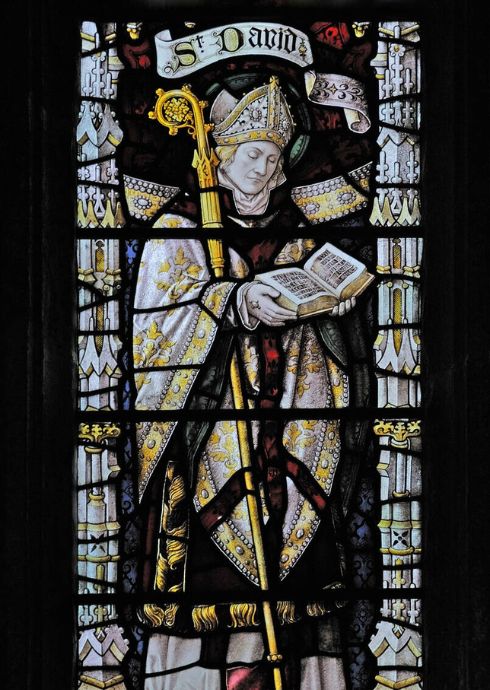
Saint David’s Day, also known as “Dydd Gŵyl Dewi Sant” in Welsh, is a national holiday in Wales celebrated on March 1st each year in the honor of saint david. he is widely considered to be the patron saint of Wales. He was born in the late 5th century, and became a prominent figure in Welsh Christianity, establishing many monastic settlements throughout the country. This day is significantly for the commemorates for the patron saint of Wales, Saint David, who was a Welsh bishop in the 6th century. It is a significant day for Welsh people.

One of the most famous stories about him is that he performed a miracle at a Synod held in Brefi, where he caused the ground beneath him to rise up into a hill so that he could be seen and heard by all the attendees. This event became known as the “Miracle of the Leek” and is still celebrated in Wales today by the wearing of leeks or daffodils, which are both symbols of the country. He was known for his ascetic lifestyle and devotion to prayer, and his teachings were highly regarded by his followers.

He was a Welsh bishop who lived in the 6th century, also known as Dewi Sant in Welsh. He was born in Pembrokeshire, Wales, and became a prominent figure in the Welsh church. he was known for his piety, humility, and his ability to perform miracles. One of the most famous stories about Saint David is that he caused the ground to rise beneath him during a sermon so that everyone could see and hear him better. He is also credited with performing other miracles, such as restoring the sight of a blind man and bringing a dead boy back to life. then he became the patron
saint of Wales, and his feast day, March 1st, is celebrated as a national holiday in Wales. His influence on Welsh culture and history is significant, and his legacy continues to be celebrated and honored to this day.
he became famous for his preaching and for his miraculous healing powers. As his influence spread throughout Wales and beyond, he became known as a symbol of Welsh identity and pride. After his death, he was venerated as a saint, and his feast day on March 1st was celebrated as a holy day in Wales. Over time, Saint David’s Day became a national holiday in Wales, and is now a day of celebration and reflection on Welsh heritage and culture.
As Saint David is an important historical figure in Welsh Christianity and culture. he founded numerous monastic settlements throughout Wales, which played a significant role in the spread of Christianity across the country. Saint David’s ascetic lifestyle and dedication to prayer served as an example to his followers, inspiring many to adopt similar practices of self-discipline and devotion. Saint David’s legacy extends beyond his spiritual teachings, as he also played an important role in Welsh politics. He was known for his advocacy of peace and reconciliation, and is credited with helping to unite the Welsh kingdoms under a single ruler. Additionally, he spoke out against slavery and worked to free enslaved individuals during his lifetime.
Perhaps one of the most famous stories associated with Saint David is the “Miracle of the Leek”. At a Synod held in Brefi, he caused the ground beneath him to rise up into a hill so that he could be seen and heard by all the attendees. This event is commemorated to this day by the wearing of leeks or daffodils, both of which are symbols of Wales.
Saint David’s Day, celebrated annually on March 1st, is a national holiday in Wales and a significant cultural event. The day honors Saint David, and is celebrated with traditional foods, festivals, and parades. Unique traditions associated with the holiday include the wearing of Welsh national dress and the giving of intricately carved wooden lovespoons as gifts.
The legacy of Saint David and the celebration of Saint David’s Day are important components of Welsh heritage and identity. Through his teachings and actions, Saint David inspired generations of Welsh people to embody the values of self-discipline, devotion, and compassion. Saint David’s Day serves as a reminder of the rich cultural history of Wales and the enduring legacy of this beloved patron saint.
Saint David’s Day on March 1st is a significant holiday in Wales, celebrating the life and work of Saint David, the patron saint of Wales. It’s an important cultural event for the Welsh people, marked by parades, festivals, and traditional clothing. Welsh cuisine, such as cawl, Welsh rarebit, and bara brith, is enjoyed on the holiday, along with sweet griddle cakes known as Welsh cakes.
Festivals and parades throughout Wales offer entertainment and a chance to celebrate Welsh heritage and culture. Although less recognized compared to other UK national holidays, Saint David’s Day remains a meaningful way for Welsh people to demonstrate their cultural pride and identity.
Kilts are not only associated with Scottish culture but are also an important part of traditional Welsh dress. Welsh kilts, known as “cilt”, have a unique tartan pattern specific to Wales and are made from wool for practicality and style. They are often worn with a matching jacket and a Sporran and sometimes a sgian dubh.
The Royal family doesn’t exclusively adore the Stewart Royal Clan plaid. They’ve also embraced the Stewart Dress and Stewart Hunting Variations on various occasions. The latter, with its concealed history, belongs to the category of Hunting plaids, recognized for their camouflaging hues—predominantly green or brown, occasionally punctuated with vivid tones. Reputedly the Queen’s chosen “off-duty” tartan, the Hunting Stewart design contrasts with Stewart Royal’s exclusivity, allowing those without a personal clan or district plaid to don the pattern.
The significance of these Tartan Kilts lies in their connection to Welsh heritage and identity, signifying allegiance to a particular clan or family. Popular options include the “Cymru” tartan and the “Welsh National” tartan, worn at formal events and cultural celebrations like Saint David’s Day, to honor Welsh ancestors and demonstrate pride in Welsh culture.
Here are some additional fun facts about Saint David:
Saint David’s Day is celebrated on March 1st every year in Wales.
The Welsh flag, with a red dragon on a green and white background, represents Welsh mythology and Saint David. It is an important symbol of Welsh identity and is flown at many events and celebrations in Wales.
The traditional Welsh attire includes a variety of garments such as the Welsh tartan kilt, the Welsh flannel shirt, the Welsh hat (known as the “bwci bo”), and the Welsh shawl. These garments are often worn during Welsh cultural celebrations and events, and are a symbol of Welsh heritage and pride.
Even if you’re not in Wales, there are still ways to celebrate Saint David’s Day. You can:
Input your search keywords and press Enter.
